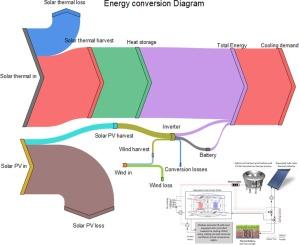用于提高食品保鲜效果的可再生混合制冷系统:数字孪生设计与性能评估
IF 9.9
1区 工程技术
Q1 ENERGY & FUELS
引用次数: 0
摘要
本研究提出了一种利用混合可再生能源驱动的混合制冷系统实现可持续冷却系统的新方法。该系统包括一个由垂直风力涡轮机与生物光电薄膜集成的模块单元,以提供可持续能源。混合制冷系统结合了蒸发和太阳热驱动的吸附冷却系统。此外,还建议使用有限体积的土壤进行热能储存。实验数据为开发集成系统的数字孪生系统、土壤热物理特性、风力涡轮机性能以及其他系统组件的技术规格提供了依据。这种可持续冷却成套设备具有成本效益和空间效率,尤其适用于偏远或离网地区。值得注意的是,蒸发冷却器和冷水盘管可产生 20.4 千瓦的冷却效果,而太阳能发电在 1053 瓦/平方米的强度下可达到 12.38 千瓦。风速为 3.5 米/秒时,年平均发电量为 1.7 千瓦。在最佳条件下,风速为 9.88 米/秒时,风力发电量可达 7.99 千瓦。风力发电与太阳能发电的比例为 1.1 至 1.3。通过太阳能集热器、地下蓄热装置和可再生能源辅助加热器,该系统可有效满足每月约 74 千兆焦耳的峰值热能需求。这项研究为未来偏远地区冷藏设施可持续能源解决方案的技术经济优化和进步铺平了道路。本文章由计算机程序翻译,如有差异,请以英文原文为准。

Renewable-driven hybrid refrigeration system for enhancing food preservation: Digital twin design and performance assessment
This study presents a new method for sustainable cooling systems using a hybrid refrigeration system powered by hybrid renewable energy sources. The system comprises a modular unit of vertical wind turbines integrated with bio-photovoltaic films to provide sustainable energy. The hybrid refrigeration system combines evaporative and solar thermal-driven adsorption cooling systems. In addition, a finite volume of soil is proposed for thermal energy storage. Experimental data inform the development of a digital twin for an integrated system, soil thermophysical characteristics, wind turbine performance, and technical specifications for other system components. This sustainable cooling package is cost-effective and space-efficient, particularly in remote or off-grid locations. Notably, the evaporative cooler and chilled water coil contribute to a cooling effect of 20.4 kW, and solar power generation reaches 12.38 kW at an intensity of 1053 W/m2. The annual electrical output averages 1.7 kW at a wind speed of 3.5 m/s. Under best conditions, wind power can surge to 7.99 kW at 9.88 m/s. The ratio of power generated by wind to solar energy ranges from 1.1 to 1.3. The system effectively meets a peak thermal energy demand of approximately 74 GJ/month, facilitated by solar collectors, underground thermal storage, and a renewable energy-fed auxiliary heater. This study paves the way for future techno-economic optimisation and advancements in sustainable energy solutions for remote cold storage facilities.
求助全文
通过发布文献求助,成功后即可免费获取论文全文。
去求助
来源期刊

Energy Conversion and Management
工程技术-力学
CiteScore
19.00
自引率
11.50%
发文量
1304
审稿时长
17 days
期刊介绍:
The journal Energy Conversion and Management provides a forum for publishing original contributions and comprehensive technical review articles of interdisciplinary and original research on all important energy topics.
The topics considered include energy generation, utilization, conversion, storage, transmission, conservation, management and sustainability. These topics typically involve various types of energy such as mechanical, thermal, nuclear, chemical, electromagnetic, magnetic and electric. These energy types cover all known energy resources, including renewable resources (e.g., solar, bio, hydro, wind, geothermal and ocean energy), fossil fuels and nuclear resources.
 求助内容:
求助内容: 应助结果提醒方式:
应助结果提醒方式:


